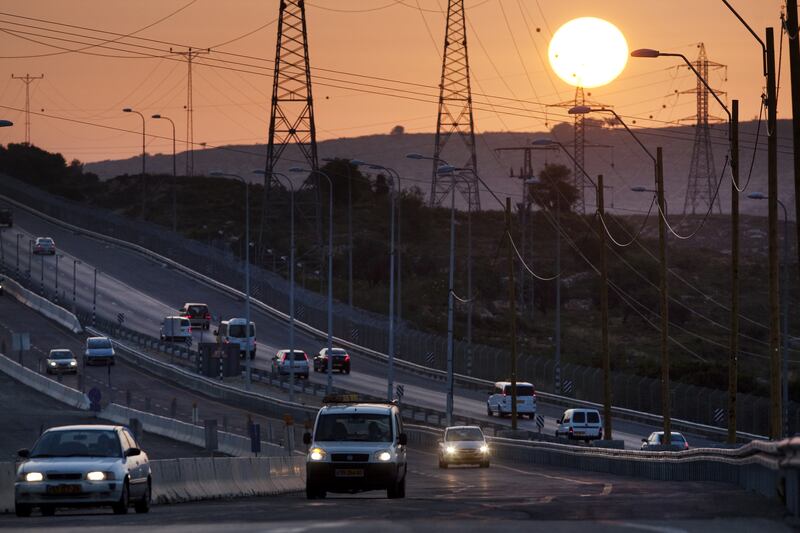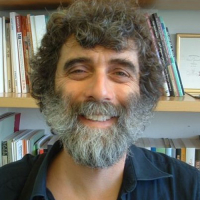I arrived back in Israel on a pre-dawn flight and decided to take the minibus shuttle to Jerusalem rather than splurging on a taxi. At that hour, it took time for the van to fill. I stood on the sidewalk, happy not to be breathing airplane cabin air. Just when some German tourists showed up to take the last seats, I noticed the writing on the side of the shuttle, advertising that it took Road 443. Unhappy at the prospect of making the other passengers wait for another traveler to show up, I climbed in, and spent the ride home feeling even more unhappy about the route.
As a journalist covering settlements, I can't avoid West Bank roads. In fact, no Jerusalemite can really avoid highways cutting through occupied territory; the main route from Tel Aviv to the capital briefly crosses the Green Line. But I have a particular distaste for 443, the secondary route, a highway built on layers of deception. And practically the last thing I'd done before vacation was digging through the most recently declassified layers.

Road 443, for those unfamiliar with the local geography, runs from the town of Lod into the West Bank hills to the north end of Jerusalem. Israel built it in the 1980s, partly along the route of an older road that connected Palestinian villages with Ramallah.
Highways take up space, and the Israeli military expropriated land from local Palestinians. Some of them petitioned Israel's Supreme Court, arguing that the road served Israeli transportation needs, and that International law doesn't allow an occupying power to seize property for its own benefit. The state's answer was that the project was really meant to give the growing Palestinian population a modern highway. The court accepted the state's claims at face value.
When the Second Intifada broke out, Palestinians gunmen killed several Israelis on the road. In theory, the army could have protected other Israelis by ordering them not to drive 443, just as it banned them from entering Palestinian cities. Instead, the IDF made the road off-limits to Palestinians, for whom it was supposedly built. In 2009, after another legal battle, the Supreme Court ordered the IDF to let Palestinians back on the highway. The army responded with security arrangements that were only a marginal improvement.
To be fair to the justices in the original case, they never saw the papers that tell the road's real story. To start with, they didn't see the classified original version of Labor politician Yigal Allon's plan, written immediately after the Six-Day War, for annexing and settling pieces of the West Bank. Inter alia, Allon said Israel should widen the corridor of land connecting Jerusalem to the coast so that it included the old road to Ramallah.
The Allon Plan largely guided the settlement efforts of Labor governments for the next decade. Declassified papers from the spring of 1976, which I found in then-Defense Minister Shimon Peres's files on settlement, record the crucial decision by a ministerial committee to build what became Road 443. The highway served the same purpose as settlements: It expressed Allon's territorial strategy, and his insistence that Israel should "create facts" by building on land it intended to keep. In effect, the highway would be a long, narrow settlement.
Last month, I got the chance to look at more recently released files relating to the road in the Israel State Archives. After the Likud took power in 1977, it adopted a new strategy of chopping up the West Bank by creating several west-to-east strips of Israeli settlement. The road fit perfectly, and appears as a bright red line on Likud settlement proposals. Here and there in the planning process, the Palestinian communities along the route get mentioned—as a potential impediment. A 1979 letter from a military government officer warns that highway planners must hurry to complete and get approval for the precise route. Otherwise, Palestinians might build houses where the road should run, making legal battles over seizing the land more likely. Road 443 wasn't built for the local Palestinians; it was built despite them.
I thought about this riding up the hill, and about how the road and the occupation itself have become almost unnoticed parts of Israeli life. Almost, but not completely: As we came into Jerusalem, a passenger behind me quietly mentioned to his wife that they'd entered Israel twice in the same day: Once at the airport, and again here.
"Sunlight is… the best of disinfectants," as Louis Brandeis famously said. The primary responsibility for shedding light on any government's deceptions rests on its own citizens. But in this case, Israel's friends can help out greatly. That, for instance, is why the recent European Union economic sanctions on settlements are so important to Israel's domestic debate: They insistently draw a distinction between Israel and occupied territory. That's also the distinction between normalcy and a ride home on Road 443.





